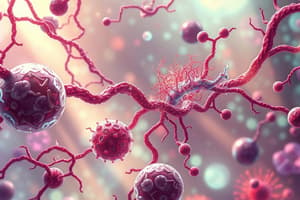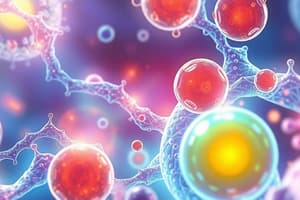Podcast
Questions and Answers
What is the role of the nucleus in a cell?
What is the role of the nucleus in a cell?
- It controls metabolic reactions. (correct)
- It produces energy for cellular processes.
- It surrounds the cell membrane.
- It stores nutrients for the cell.
Which of the following statements about the cell wall is correct?
Which of the following statements about the cell wall is correct?
- It is made of proteins.
- It contains genetic material.
- It is living and actively participates in metabolism.
- It is freely permeable and helps maintain cell shape. (correct)
What is the primary function of mitochondria in a cell?
What is the primary function of mitochondria in a cell?
- Formation of energy (correct)
- Control of substance movement
- Protein synthesis
- Chemical reaction facilitation
What characteristic do red blood cells and xylem vessels share regarding their nuclei?
What characteristic do red blood cells and xylem vessels share regarding their nuclei?
Which of the following components is responsible for protein synthesis?
Which of the following components is responsible for protein synthesis?
What determines which proteins a cell can produce?
What determines which proteins a cell can produce?
What is a key characteristic of the cell membrane?
What is a key characteristic of the cell membrane?
What does 'turgid' refer to in the context of plant cells?
What does 'turgid' refer to in the context of plant cells?
What is the main component of the cytoplasm?
What is the main component of the cytoplasm?
Which of the following statements about cells is false?
Which of the following statements about cells is false?
What characteristic of red blood cells allows for efficient oxygen exchange?
What characteristic of red blood cells allows for efficient oxygen exchange?
What material strengthens xylem cells and prevents them from collapsing under pressure?
What material strengthens xylem cells and prevents them from collapsing under pressure?
How do cells contribute to the formation of organs in living organisms?
How do cells contribute to the formation of organs in living organisms?
What is the primary function of xylem vessels in plants?
What is the primary function of xylem vessels in plants?
Which statement correctly describes the development of cells into tissues and organs?
Which statement correctly describes the development of cells into tissues and organs?
What is the primary function of the bacterial cell wall?
What is the primary function of the bacterial cell wall?
What is the function of the capsule in bacteria?
What is the function of the capsule in bacteria?
Which component of bacteria carries genes and is utilized in genetic engineering?
Which component of bacteria carries genes and is utilized in genetic engineering?
What is found in the cytoplasm of bacteria?
What is found in the cytoplasm of bacteria?
How does the flagellum contribute to bacterial movement?
How does the flagellum contribute to bacterial movement?
What is the primary function of the sap vacuole in a fully developed plant?
What is the primary function of the sap vacuole in a fully developed plant?
Which of the following statements is true regarding chloroplasts?
Which of the following statements is true regarding chloroplasts?
How do root hair cells enhance water and ion absorption?
How do root hair cells enhance water and ion absorption?
Which of the following statements best describes the difference between plant and animal cells?
Which of the following statements best describes the difference between plant and animal cells?
What characteristic distinguishes the cell membrane from the cell wall?
What characteristic distinguishes the cell membrane from the cell wall?
What is the primary characteristic of binary fission in prokaryotic organisms?
What is the primary characteristic of binary fission in prokaryotic organisms?
During binary fission, how is the DNA arranged before cell division?
During binary fission, how is the DNA arranged before cell division?
What factors can affect the division frequency of bacteria?
What factors can affect the division frequency of bacteria?
What happens to the cell wall during binary fission?
What happens to the cell wall during binary fission?
Which statement is true regarding the replication of genetic material in binary fission?
Which statement is true regarding the replication of genetic material in binary fission?
Flashcards are hidden until you start studying
Study Notes
Metabolism
- Metabolism occurs in organelles, including the nucleus and chloroplast.
Nucleus
- Largest organelle visible in a cell, located in the cytoplasm.
- Specialized cells like red blood cells and xylem vessels lack a nucleus.
- Regulates metabolic reactions and contains genes within chromosomes.
- Genes, composed of Deoxyribose Nucleic Acid (DNA), dictate protein production and inheritance of physical traits.
Cell Wall
- Non-living structure surrounding the cell membrane in plants.
- Composed of cellulose, a carbohydrate that is freely permeable to salts and water.
- Maintains plant shape by becoming turgid, which results from water absorption creating internal pressure.
Cells
- Basic structural and functional unit of organisms, with 10-100 million cells in the human body.
- Shared components in plant and animal cells include cytoplasm, nucleus, cell membrane, ribosomes, and mitochondria.
Mitochondria
- Known as the powerhouse of the cell, responsible for energy production during respiration.
Ribosome
- Site of protein synthesis, essential for cellular function.
Cell Membrane
- Thin surface layer made of proteins and lipids, not visible under regular microscopes.
- Partially permeable, controlling substance movement in and out of the cell, while retaining cell contents.
Cytoplasm
- Jelly-like substance making up most of the cell, involved in numerous chemical reactions.
Blood Cells
- Most common cells in the human body derived from bone marrow.
- Mature blood cells lose their nucleus, acquiring a biconcave disk shape for enhanced oxygen exchange.
- Flexible structure facilitates movement through narrow blood capillaries.
Xylem Vessels
- Composed of dead, hollow cells transporting water and ions from roots to leaves.
- Mature cells elongate and lose walls between cells, with lignin providing structural support.
Tissue and Organ Formation
- Similar cells group to form tissues; similar tissues combine to create organs, which work in concert within organ systems to sustain life.
Bacteria
- Unicellular organisms that are simpler and smaller than plant and animal cells.
Bacterial Cell Wall
- Comprised of peptidoglycan, a protein distinct from cellulose and chitin, providing structural support.
Capsule
- Protective slime layer around bacteria, preventing desiccation.
Cytoplasm in Bacteria
- Contains minimal organelles and lacks a nucleus; chromosomes exist as a loose single strand.
Plasmids
- Circular DNA rings carrying genes, utilized in genetic engineering.
Flagellum
- A tail-like structure enabling bacteria to swim by moving in a propeller-like motion.
Sap Vacuole
- Large, permanent cytoplasmic space in mature plants, containing a sugary solution that acts as a solvent.
Chloroplast
- Large organelle in green plant parts, containing chlorophyll for photosynthesis.
Differences Between Plant and Animal Cells
- Animal cells are smaller and contain centrioles; they lack a rigid cell wall, allowing for flexible shape.
Specialized Cells
- Root hair cells facilitate water absorption by increasing surface area through their elongated shape, optimizing osmosis and transport of ions.
Binary Fission
- Reproductive process in prokaryotic organisms (like bacteria) where a single cell divides into two after replicating genetic material.
- Resulting cells possess similar genetic material, with plasmids distributed randomly during division.
- Bacteria can divide every 20 minutes given favorable conditions of warmth, moisture, and nutrient availability.
Studying That Suits You
Use AI to generate personalized quizzes and flashcards to suit your learning preferences.




